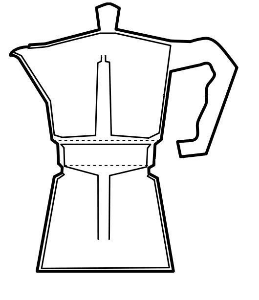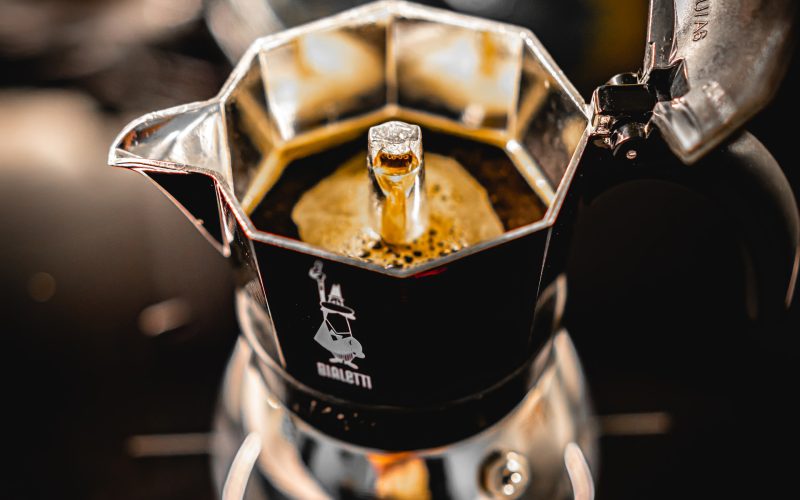If you’re on the hunt for the world’s best coffee at home, then you’re in luck—in this article we’ll cover everything you need to know about how to use a moka pot.
The moka pot is considered one of the most popular brewing methods in the world.
Why? Because it makes great coffee, of course.
Plus the device itself is interesting and unique—transporting us to somewhere exotic. An Italian cliff-side cafe, sipping on an authentic cup of Italian coffee, perhaps?
Let’s dive in.
What is a Moka Pot?
The Moka Pot is a brewing device that dates back to the early 20th century and invented by Italian company Bialetti and founder, Alfonso Bialetti.
Popular mostly in Europe and Latin America, these devices are similar in size and shape to a coffee percolator—but they function quite differently.
They’re built of aluminium, stainless steel, or other metal alloy.
The Moka Pot is often referred to as a stovetop espresso maker, although this is somewhat of a misnomer. The moka pot is a coffee maker, not an espresso machine. If you want to brew true espresso, you’ll need a device capable of achieving much higher pressure (about 5-10x to achieve 9 bar.)
Also, don’t confuse moka coffee with “mocha” which is a flavored coffee drink with chocolate. The moka pot was originally invented in the Italian city of Mocha (where it got its name), but sadly it doesn’t turn coffee into chocolate.
It does, however, produce a rich, creamy cup of coffee that coffee snobs and baristas alike can appreciate.
How Does a Moka Pot Work?
Before we dig into brewing coffee with the moka pot (often called “moka coffee” because it’s unique and specific to brewing with this device), let’s first begin by understanding how the moka pot works.
Similar to a percolator, water is added to the bottom chamber.
Coffee grounds are added into a funnel-shaped metal filter basket that sits on top of the water, sealed with a gasket.
When the moka pot is heated, the air inside the lower chamber expands and creates pressure that forces the water up through the funnel, passing through the coffee grounds, and then into the upper chamber.

Surprisingly, you aren’t technically boiling water during the brewing process.
On the contrary, it’s actually preferable to heat the water (and air) gradually for optimal brewing. Without getting into a full-blown physics lesson (yes, the study has been done), it is the expanding gas (air) in the lower chamber that is forcing the water up into the coffee grounds—not the water itself heating to a boil.
What Do You Need to Make Moka Pot Coffee?
Alright, so now that you understand at least a little bit of the physics involved, let’s talk about what you actually came here to learn—how to brew coffee.
You need 3 things to brew moka pot coffee:
- Moka pot (AKA stovetop coffee maker)
- Warm water (about 340-350 grams for a 6-cup moka pot)
- Ground coffee (20-22 grams for a 6-cup moka pot)
We’ll cover the exact step-by-step instructions in a moment. But, first, one final detour. Let’s talk briefly about the coffee grind and the water you should use when brewing with a moka pot.
Finely Ground Coffee Only
Remember that the entire system is built on pressure. To brew properly, you’ll need to build and maintain pressure within the moka pot—by adding heat.
And another factor in that pressure if how tightly you pack ground coffee into the filter basket.
Use fine-ground coffee the maximize flavor and maintain pressure.
Use Warm Water in Your Moka Pot
Hot coffee is made with hot water—we all know that.
But what temperature water should you begin with when using a moka pot?
The answer might surprise you.
According to science, the ideal temperature is 70 degrees Celsius (about 158 degrees Fahrenheit).
This means that to brew the perfect pot, you should preheat the water before adding it to your moka pot and shoot for this specific temperature before you begin the brewing process.
This allows the Moka pot to heat up the water and extract the maximum amount of oils and flavor from the coffee grounds without burning the
If you brew with cold water, you’ll under-extract the coffee, meaning it won’t have the same flavor and mouthfeel as an authentic cuppa.
How to Use a Moka Pot to Make Coffee (Step-by-Step Instructions)
Okay, now, with all of that out of the way, let’s get to the exact process for how to use a Moka Pot.
Let’s get to making coffee!
Here’s how you brew coffee in a moka pot:
- Step #1: Pre-heat the water
- Step #2: Add water to the bottom chamber
- Step #3: Add fine-ground coffee to the filter basket
- Step #4: Seat the filter basket in the gasket
- Step #5: Brew over medium heat until you hear a gurgling sound
- Step #6: Pour
Step #1: Pre-heat the water
As we discussed above, there is science to back up the ideal temperature here. And, unlike other brewing methods, you actually do not want to start with cold water.
Instead, it’s ideal for you to bring your water up to a temperature of about 70-degrees Celsius or 158-degrees Fahrenheit before pouring it into the lower chamber of the moka pot.
Don’t boil the water.
Step #2: Add water to the bottom chamber
Once the water is up to temperature, you can pour it into the body of the coffee maker.
In most brewers, there will be a fill line for the water. Fill only to that line—or just below the safety valve on the side of the moka pot.
Do not overfill the lower chamber (this will result in less coffee rather than more coffee).
Step #3: Add fine-ground coffee to the filter basket
Fill the filter basket with fine-ground coffee. (Generally about 20-22 grams)
You can use either pre-ground coffee or coffee beans and a coffee grinder to achieve the desired grind.
Don’t tamp the grounds—remember this isn’t true espresso.
Step #4: Seat the filter basket in the gasket
Now you’ll assemble the coffee pot by placing the funnel and filter basket into the center section of the moka pot, between the top chamber and bottom chamber.
The funnel or tube should stick down into the water.
Make sure that the basket is seated snugly into the gasket so it maintains proper pressure.
Then screw on the top chamber.
Step #5: Brew over medium heat until you hear a gurgling sound
Now comes the actual brewing process.
Place the moka pot on a heat source—generally, a gas stove, although some steel moka pots can also work on induction cooktops—over medium heat.
The brewing time will vary from about 2.5 to 6 minutes, depending on what temperature water you started with.
Once you hear a gurgling sound, this means that brewing is complete. Remove it from the heat immediately.
Ideally, you actually want to catch the brew just before the gurgling starts. You can open the top of the pot to see the coffee being brewed and “eyeball it” so you don’t risk burning the coffee.
Let the moka pot sit for 30-90 seconds while the coffee continues to flow into the upper chamber.
Step #6: Pour
Now, the part you’ve been waiting for.
Grab the moka pot and pour directly into a cup.
Be careful as the body and handle may be hot from the flame.
Enjoy!
FAQs About Moka Pots
Does a Moka Pot brew espresso?
Nope. You can’t make true espresso with a moka pot because it doesn’t supply enough pressure. This means you won’t get the same level of deep, rich flavor, and—maybe most importantly—you won’t get crema.
But the coffee brewed with a moka pot is often considered similar in depth and flavor to espresso.
Many people consider it similar to an Americano. They also often use moka pot coffee to make lattes or cappuccinos—even iced coffee.
What the best moka pot for homebrew coffee?
The quintessential correct answer here is the Bialetti Moka Pot.
It’s the original. And, in some areas (e.g., Italy), it’s the category namesake—people just call all moka pots a Bialetti.
They also make other models like the Bialetti Moka Express if you’re looking for something smaller.
But for the full list, check out our review of the best moka pots.
If you’re looking for something specific, check out:
- Best 12-Cup Stovetop Espresso Makers (Moka Pots)
- Best 2-Cup Stovetop Espresso Makers (Moka Pots)
- Best Moka Pots for Camping
How does moka pot coffee compare to other brewing methods?
Each brewing method has its own pros—and cons.
For a detailed review, check out our comparisons:
- Moka Pot vs French Press
- Moka Pot vs Siphon
- Moka Pot vs Espresso
- Moka Pot vs Drip Coffee

